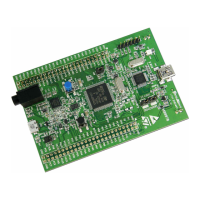PM0214 Rev 9 139/262
PM0214 The STM32 Cortex-M4 instruction set
261
3.9.1 BFC and BFI
Bit Field Clear and Bit Field Insert.
Syntax
BFC{cond} Rd, #lsb, #width
BFI{cond} Rd, Rn, #lsb, #width
Where:
• ‘cond’ is an optional condition code, see Conditional execution on page 65.
• ‘Rd’ is the destination register.
• ‘Rn’ is the source register.
• ‘lsb’ is the position of the least significant bit of the bitfield. lsb must be in the range 0 to
31.
• ‘width’ is the width of the bitfield and must be in the range 1 to 32-lsb.
Operation
BFC clears a bitfield in a register. It clears width bits in Rd, starting at the low bit position lsb.
Other bits in Rd are unchanged.
BFI copies a bitfield into one register from another register. It replaces width bits in Rd
starting at the low bit position lsb, with width bits from Rn starting at bit[0]. Other bits in Rd
are unchanged.
Restrictions
Do not use SP and do not use PC.
Condition flags
These instructions do not affect the flags.
Examples
BFC R4, #8, #12 ; Clear bit 8 to bit 19 (12 bits) of R4 to 0
BFI R9, R2, #8, #12 ; Replace bit 8 to bit 19 (12 bits) of R9 with
; bit 0 to bit 11 from R2

